Jedi Order Core
1. Introduction
The Jedi Order is an ancient sect of Force users dedicated to the study and application of the Force for the greater good. It is a diverse group, whose members display interest and talent in activities including peacekeeping, diplomacy, combat, intelligence gathering, and research into the mysteries of the Force. Within the Brotherhood, members of the Jedi Order walk the Light Path. They provide a counterweight to the scheming and violence of the Brotherhood’s Sith Order, and must always be on guard against their “brothers’” deceit.
2. History
2.1 Pre-Brotherhood History
The Jedi Order predates the foundation of the Galactic Republic, tracing back to 36,453 BBY, with the arrival mysterious artifacts known as Tho'Yor on the planet Tython. The Tho'Yor, pyramidal starships, had collected Force sensitives from around the galaxy and spread them out across Tython. The Tho’Yor artifacts were then used to create eight new temples forming the foundation for what would become known as the Je'daai.
As these proto-Jedi researched the Force, they divided it into two parts named after the moons of Tython: Ashla, the light side, and Bogan, the dark side. The Je’daai were not inclined towards the light or dark sides of the Force, but tried to keep a balance between both sides. However, over time the number of Je’daai who were attracted by Bogan (the dark side) increased, eventually leading to a civil war where those who followed the dark side lost and were exiled from Tython. The remaining Je’daai, followers of the light side, abandoned their prior commitment to balance and renamed themselves the Jedi Order.
As a result of the civil war, the planet Tython was too badly ravaged to support life, prompting the Jedi Order to take to the stars in search of a new home. After some time traveling, they discovered and colonized the world Ossus, establishing an Academy there to train new Jedi. The Jedi Order remained undisturbed and mostly unnoticed outside their space until 25,053 BBY, when the Galactic Republic was formed. Ambassadors of the Jedi Order approached the Republic and swore loyalty to the new government as their protectors and guardians.
Over the next 20,000 years, the Republic and the Jedi Order experienced long periods of peace and some minor conflicts, and they expanded throughout the Core Worlds and part of the Outer Rim territories. The Jedi established many new academies during this time.
The first major conflict that the Republic suffered started in 5,000 BBY, when the siblings Gav and Jori Daragon encountered the Sith Empire while scouting for new hyperspace routes. This was an interstellar empire ruled by the descendants of those users of the dark side who were expelled from Tython thousands of years earlier. During this conflict, known as the Great Hyperspace War, two Jedi, Master Ooroo, and his student, Odan-Urr, played major roles that directly impacted the war’s result.
Odan-Urr foresaw the coming conflict and tried to warn the Republic, but his warning came too late. The Sith Empire took the Republic by surprise, gaining the upper hand in the early fighting.
Master Ooroo, a Celegian scholar, sacrificed himself during one of the battles in the Great Hyperspace War while Odan-Urr -- using the Force power known as Battle Meditation -- coordinated the Republic defenses and managed to put an end to the conflict on their planet. Defeated on other fronts as well, the Sith Lord Naga Sadow retreated with his forces and went into exile.
Following the Great Hyperspace War, Odan-Urr established the Great Jedi Library on Ossus. This was one of the most notable buildings in the history of the Jedi Order, and it served as a center of knowledge and training for all Jedi for a millennium. The Jedi Order also became more centralized during this period, with the Jedi High Council directing members of the Order.
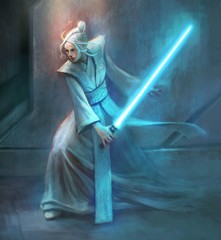
After a period of relative peace and stability, the Jedi faced one of their greatest challenges: the Jedi Civil War. Two Jedi, Revan and Malak, defeated a Mandalorian invasion that threatened to topple the Republic. However, the Jedi Council disapproved of the tactics Revan employed in fighting back the invasion as well as the power he seemed to wield over his growing group of followers, called Revanchists. Revan, Malak, and the majority of the Revanchists ignored the Council’s orders to return to Coruscant. Revan and Malak journeyed to the Unknown Regions where they were overcome by the Sith Emperor Vitiate and turned to the dark side. They returned to the Republic with their Revanchist army in tow, and began a devastating campaign against the Jedi and the Republic.
During the Jedi Civil War, a Jedi named Bastila Shan played a deciding role in the conflict because of her mastery over the Battle Meditation power. Bastila Shan led a small strike team onto Revan’s command vessel to capture Revan. During their infiltration, Darth Malak betrayed his former master and attacked Revan, hoping to claim the title Dark Lord of the Sith for himself. Bastila, however, succeeded in saving an unconscious Revan. The Jedi Council imprinted the identity of a new Jedi Padawan on Revan’s mind, and Bastila Shan then worked with Revan to defeat Darth Malak. Three centuries later, Bastila’s descendant Satele Shan, became the one of the most famous Jedi of her time, rediscovering Tython and becoming Grand Master of the Jedi Order.
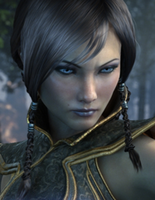
Following Malak’s defeat, Revan -- once again aware of his true identity -- returned to the Unknown Regions alone. Shortly thereafter, three Sith Masters known as the Sith Triumvirate launched a surprise attack on the Jedi conclave at Katarr, eliminating most of the Jedi and the Council in a single strike. As the Sith began hunting down the surviving Jedi, the few remaining Council members ordered the surviving Jedi to scatter and go into hiding. The Jedi Order was, for all intents and purposes, disbanded. Exiled Jedi Meetra Surik discovered and trained several Force sensitives. She and her companions eventually managed to defeat all three Sith Lords and began the work of rebuilding a new Jedi Order from the ground up.
Three hundred years after the Sith Triumvirate’s defeat, the Jedi and the Republic were once again attacked by the Sith in what became known as the Great Galactic War. The Sith destroyed the Jedi Temple on Coruscant and conquered many worlds from the Republic, but were unable to secure total victory.
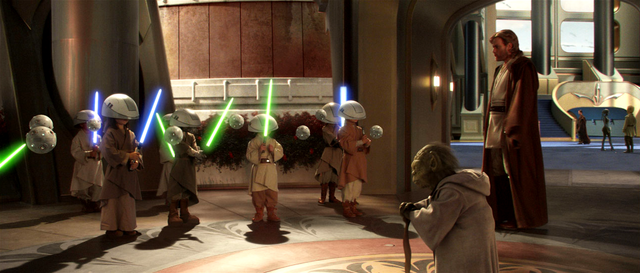
A millennium later, during the era known as the Fall of the Republic, the Sith Lord Darth Sidious -- known publicly as Senator Palpatine -- orchestrated a political crisis that led the Republic Senate to elevate him to the position of Chancellor and grant him emergency war powers. He used his new power to end the Republic and establish the first Galactic Empire, with himself as Emperor, in its wake. Darth Sidious turned the young padawan Anakin Skywalker to the dark side through manipulation and the promise of greater power. He also issued the infamous Order 66, which led to the deaths of nearly all Jedi in the galaxy. The two best known survivors -- Grand Master Yoda and Master Obi-wan Kenobi -- escaped into exile.
Now known as Darth Vader, Anakin Skywalker continued to hunt Jedi survivors across the galaxy until his defeat -- and redemption -- at the hands of his own son, Luke Skywalker. Luke had been trained in secret as a Jedi by Obi-wan Kenobi and Yoda, and helped lead the Rebel Alliance to victory over the Empire at the Battle of Endor. Both Darth Sidious and Darth Vader perished during the battle, though the future of the galaxy remained uncertain.
2.2 Brotherhood History
The history of the Jedi Order within the Brotherhood is closely intertwined with that of planet Harakoa (renamed shortly after the arrival of the Jedi as New Tython), as until recently that was where the majority of the Order’s members within the Brotherhood resided.

The Jedi arrived on Harakoa after the planet was colonized by escaping remnants from the Galactic Empire. They found the planet in conflict as the Harakoans, the original natives of the planet, were attacked by the expanding colonists and the Harakoans were answering in the same manner. Battles escalated as the Jedi tried to contact both species and come to a peaceful agreement between them. Eventually the Jedi established a truce between the two groups and the place where this truce was made would later become the capital of New Tython, Menat Ombo.
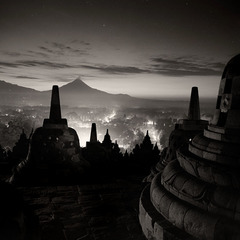
It was in 27 ABY when the Jedi made contact with the Brotherhood. Aware that they were not able to compete with the Brotherhood's military might, the Jedi contacted the Dark Council. To their surprise, they were permitted to live in peace by the Grand Master Muz Ashen as long as they joined the organization. As part of the agreement, they would change their name from Acolytes of Odan-Urr to House Odan-Urr, while New Tython would be recognized as part of the Brotherhood dominion.
Suspicious but without any choice, House Odan-Urr's Jedi agreed to these terms, but the seers within the Order failed to foresee the Brotherhood's sudden attack in 29 ABY. This conflict would later become known as the Tenth Great Jedi War. The Odanites managed to establish an alliance with Jedi Master Michael Halcyon and the Mandalorian forces of Clan Ordo. The war ended in a stalemate, with the city of Menat Ombo reduced to a pile of dust and the forces of the Brotherhood retreating as swiftly as they had attacked. Although Menat Ombo was eventually reconstructed, they moved to the recently constructed Arca Praxeum, a center to train new Jedi.
In the years following GJW X, the Jedi began to slowly expand their influence within the Brotherhood beyond House Odan-Urr. Members of the order began to transfer to other Clans and Houses. Others within the Brotherhood began to openly identify as or affiliate with Jedi without repercussion. Members of the Jedi order were eventually granted seats on the Dark Council itself with Jedi serving terms as Headmaster and Herald. For all their gains, the Jedi order, with House Odan-Urr as a focal point, still faced a struggle for their very existence. During the Eleventh Great Jedi War most of the Jedi in the Brotherhood fought on the side of the rebels alongside Grand Master Cotelin, House Odan-Urr and Clan Taldryan.
Following GJW XI, the newly appointed Grand Master Pravus granted House Odan-Urr Clan status. Not long after the war, Clan Odan-Urr signed a nonaggression pact with Clan Arcona while Clan Taldryan began openly accepting Jedi Guardians into their ranks for the first time. Even with formal acceptance in two clans, a growing network of alliances and representation on the Dark Council, Jedi across the Brotherhood remain wary that one day Pravus will betray them as Ashen did.
That day came when Pravus announced to the Clans of his desire to purge the Brotherhood of what he deemed “Undesirables”. Those who did not fit into his idea of what it meant to be a perfect Sith. This split the Brotherhood in twain, with those supporting his genocidal ideas and others who opposed him. Countless lives were lost in the fight and even led to the loss of New Tython; turned into glass by the turbolasers of the Iron Legion’s fleet. Now with the Jedi of Clan Odan Urr in hiding and other Clans attacked by Pravus, the Jedi of the Brotherhood are needed more than ever to combat the darkness amongst them.
3. Philosophy
The Jedi Order as it exists in the Brotherhood is not centralized like the Jedi Order of the Old Republic was. There is no central Jedi Council in Brotherhood space which dictates the precise tenets and doctrines of those who would call themselves Jedi. Even the Council of Urr on New Tython does not make pronouncements on Force philosophy. Instead what exists within the Brotherhood is an ideologically diverse group of Jedi committed to the light side of the Force and the ideals of the Order.
The Jedi seek peace and tranquility in the galaxy. Jedi respect all life and strive to defend and protect those in need. Force users of the Light Path always avoid the dark side, regardless of Order.
Jedi within the Brotherhood can generally be categorized as followers of the Old Republic Jedi Code as originally recorded by Master Odan-Urr or of updated variations of the Code that place less emphasis on emotional detachment.
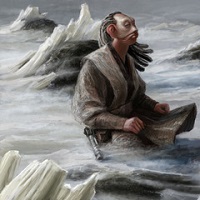
There is no emotion, there is peace.
There is no ignorance, there is knowledge.
There is no passion, there is serenity.
There is no chaos, there is harmony. There is no death, there is the Force.
- The Jedi Code, as recorded by Master Odan-Urr
4. Ranks of the Jedi Order
Traditionally, Jedi of the Old Republic only had the ranks of Padawan, Knight, Master, and for the sitting head of the Jedi Council, Grand Master. To adapt to the rank structure used by the other orders, the Jedi Order within the Brotherhood has added to the traditional ranks to allow for greater differentiation between the various stages of a Jedi’s progression.

5. Conclusion
The Jedi Order is the largest collection of Light Path Force users in the Brotherhood. It has a long and storied history, and its adherents must always beware the dangers of the dark side.
Please log in to take this course's exam